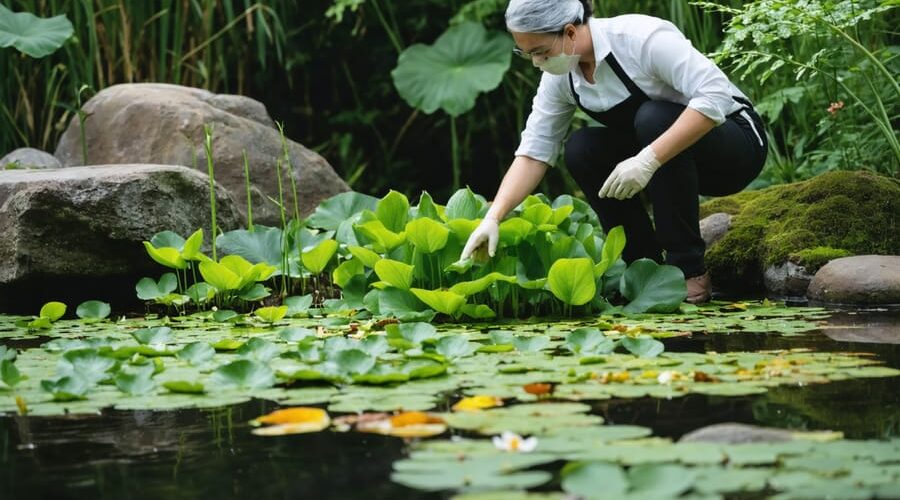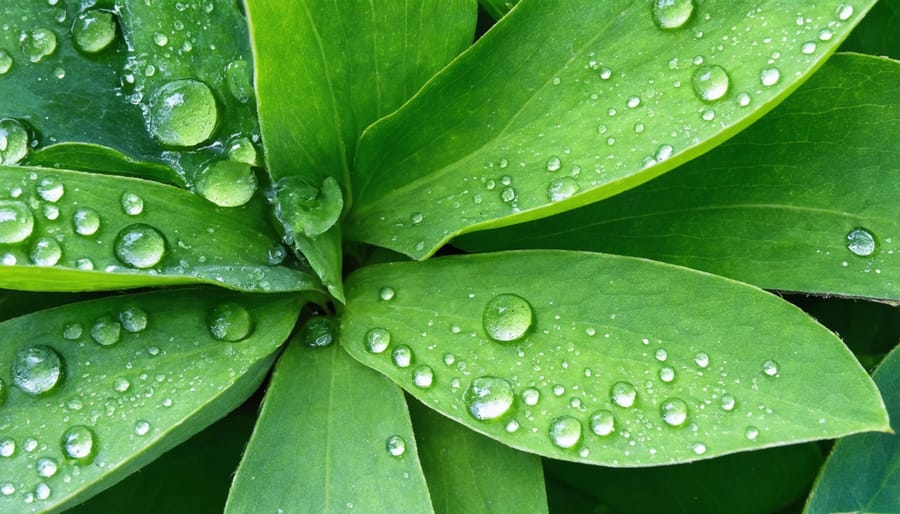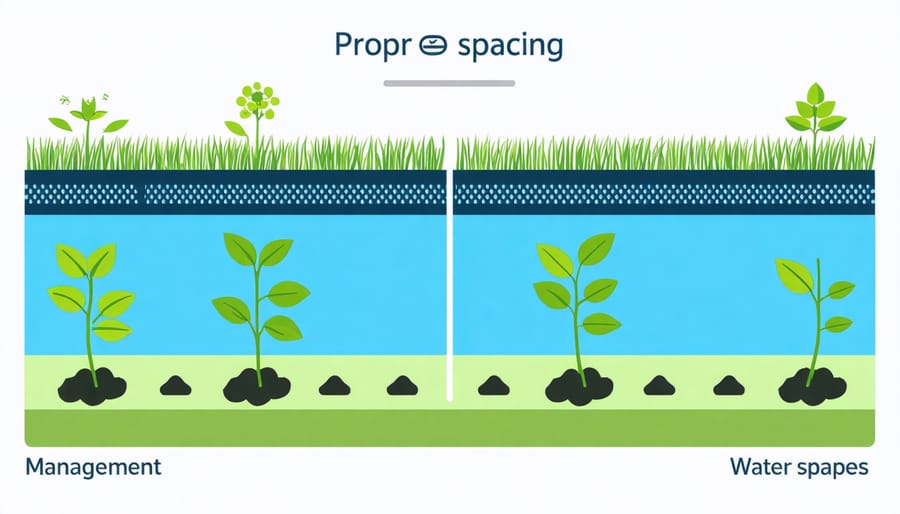
Save Your Pond Plants: Stop Edema Disease Before It Spreads
Inspect pond plant leaves for small, water-soaked blisters that eventually turn brown and corky – these are telltale signs of edema, one of the most common pond plant diseases. This physiological disorder occurs when roots absorb water faster than leaves can transpire it, causing cells to rupture and form unsightly bumps. Unlike fungal or bacterial infections, edema strikes when environmental conditions create an imbalance between water uptake and release. Understanding this distinction is crucial for pond owners, as standard disease treatments won’t resolve edema issues. The good news? This condition, while concerning, rarely proves fatal to plants and can be effectively managed through proper water and environmental control. Whether you’re maintaining a small water feature or a large pond ecosystem, recognizing and addressing edema early prevents long-term plant damage and maintains your water garden’s beauty.
Identifying Edema in Your Pond Plants
Early Warning Signs
The first signs of edema in your pond plants often appear as small, water-soaked spots on the leaves, typically on the undersides. These spots start as light green or yellowish bumps that feel slightly raised when you run your finger over them. You might notice these blisters are more prominent early in the morning or after periods of heavy rainfall.
As the condition progresses, you’ll see these spots becoming more numerous and spreading across the leaf surface. The blisters may begin to look like tiny warts, and the affected areas might take on a cork-like texture. Sometimes, the spots can appear crystal-like or translucent when held up to light.
Watch for leaves that seem unusually thick or swollen, especially after overcast days. Lower leaves are usually affected first, so check these areas regularly. You might also notice some leaves developing a crinkled or puckered appearance. If you spot white or rust-colored patches forming where the blisters were, this indicates that the affected tissue has dried out and died.

Advanced Symptoms
As edema progresses, affected leaves develop corky, brown patches where the blisters once were. These areas become rough and unsightly, often causing the leaves to curl or become distorted. In severe cases, entire leaves may yellow and drop prematurely, weakening the plant’s overall health. You might notice the stems becoming thick and brittle, with dark streaks appearing along their length.
The most concerning advanced symptoms appear when multiple parts of the plant are affected simultaneously. Water-soaked spots can merge into larger areas of damage, creating perfect entry points for secondary infections like fungal or bacterial diseases. The plant’s growth may become stunted, and new leaves might emerge already showing signs of damage.
If left untreated, edema can spread throughout the entire plant, affecting its ability to photosynthesize effectively. This results in reduced flowering, slower growth, and a generally unhealthy appearance. In extreme cases, particularly with young or vulnerable plants, severe edema can lead to complete plant failure, though this is relatively rare when proper intervention occurs.

What Causes Edema in Pond Plants
Environmental Triggers
Environmental conditions play a crucial role in the development of edema in pond plants. The most common trigger is inconsistent watering patterns, particularly when plants receive too much water too quickly. This often happens during periods of heavy rainfall or when irrigation systems malfunction.
Temperature fluctuations can also contribute to edema development. When nighttime temperatures drop significantly while soil remains warm and wet, plants continue absorbing water but can’t effectively transport it through their system. This is especially common during spring and fall when temperature swings are more dramatic.
High humidity levels combined with poor air circulation create the perfect storm for edema. In these conditions, plants can’t properly release excess water through transpiration, leading to cellular buildup. This is why edema frequently appears in greenhouses or in densely planted areas where air movement is restricted.
Soil conditions matter too. Heavy, waterlogged soil or growing media that retains too much moisture can force plants to absorb more water than they need. Poor drainage in containers or pond margins can worsen this issue, especially during periods of increased rainfall or overenthusiastic watering.
Cloudy weather can also impact plant health, as reduced sunlight means decreased transpiration rates, making it harder for plants to process excess water effectively.
Common Management Mistakes
Even experienced gardeners can make mistakes that lead to edema in their pond plants. One common error is overwatering, especially during cooler weather when plants need less water. Many enthusiasts mistakenly think more water means healthier plants, but this can actually trigger edema development.
Poor ventilation around your plants is another frequent oversight. Crowding plants too closely together or placing them in areas with stagnant air can create the perfect conditions for edema. Remember, good air circulation is essential for plant health!
Temperature management mistakes often catch gardeners off guard. Keeping plants in environments with dramatic temperature swings, particularly when cold nights follow warm days, can stress plants and promote edema. Similarly, watering with very cold water when the soil is warm can shock plant tissues.
Many gardeners also make the mistake of ignoring early warning signs. Those small, water-soaked spots might seem minor at first, but catching them early can prevent the problem from spreading. Additionally, using fertilizers incorrectly – especially applying too much nitrogen – can make plants more susceptible to edema.
Lastly, improper soil conditions, like using heavy, poorly-draining potting mix, can trap excess moisture around roots and contribute to edema development.
Treatment and Prevention Strategies
Immediate Actions
When you first spot signs of edema on your plants, quick action can help prevent the condition from worsening. Start by immediately reducing watering frequency – this is crucial as overwatering is often the primary culprit. Move affected plants to a spot with better air circulation, ensuring they’re not crowded together.
Check your greenhouse or indoor growing area’s ventilation system and adjust fans or vents to improve air movement. If you’re growing plants indoors, consider running a dehumidifier to lower moisture levels in the air. For outdoor plants, temporarily relocate containers to a more sheltered area if heavy rains are expected.
Remove any severely affected leaves, but don’t strip the plant bare – it needs some foliage to recover. Inspect the soil moisture level by inserting your finger about an inch deep; if it feels wet, hold off on watering until the top layer feels slightly dry.
Document when you first noticed the symptoms and what immediate actions you took. This information can be valuable for preventing future occurrences and adjusting your care routine. Also, check nearby plants for early signs of edema, as similar growing conditions might affect them too.
Long-term Prevention
To keep edema from returning to your pond plants, focus on maintaining a healthy pond ecosystem through consistent care practices. Start by establishing a regular watering schedule that avoids both overwatering and underwatering. Check soil moisture levels weekly using your finger or a moisture meter, and adjust watering accordingly.
Ensure proper air circulation around your plants by spacing them appropriately and trimming surrounding vegetation when needed. Installing a small fan near indoor water gardens can help prevent stagnant air conditions that contribute to edema.
Monitor your water quality monthly, testing for proper pH levels and nutrient balance. Maintain water temperatures between 65-75°F (18-24°C) for optimal plant health. Consider installing a thermometer to track temperature fluctuations.
Create a maintenance calendar to track fertilization schedules, pruning dates, and water testing. This helps you stay consistent with care routines and spot potential issues early. Remember to remove dead or declining foliage promptly, as these can create humid microclimates that encourage edema development.
Lastly, choose plant varieties known for their resistance to edema when adding new specimens to your pond. This proactive approach significantly reduces future problems.

Plant Selection Tips
When selecting suitable pond plants to minimize edema risk, focus on varieties known for their resilience to moisture fluctuations. Choose plants that naturally thrive in your local climate zone, as they’re better adapted to handle environmental stress. Plants with good air circulation between leaves, such as those with more open growth patterns, are less likely to develop edema.
Consider the specific placement of your plants carefully. Position them where they’ll receive adequate morning sun but some protection from intense afternoon heat. This balance helps regulate moisture levels within plant tissues. Avoid overcrowding, as tight spacing reduces airflow and increases humidity around leaves.
For container plants, select pots with excellent drainage and position them slightly elevated to prevent waterlogging. Some plant varieties naturally resistant to edema include many succulent species, herbs like rosemary and sage, and certain ornamental grasses. Remember to research each plant’s specific water needs before adding them to your garden, as proper matching of plants to their ideal growing conditions is key to preventing edema.
Taking care of pond plants is a rewarding hobby, but staying vigilant about edema is crucial for maintaining their health and beauty. By understanding the signs of edema – those characteristic blisters and bumps on leaves – you can catch the problem early and take appropriate action. Remember that environmental factors, particularly inconsistent watering and high humidity, are the main culprits behind this common plant disorder.
The good news is that edema is largely preventable with proper care routines. Maintaining consistent watering schedules, ensuring good air circulation, and monitoring humidity levels can significantly reduce the risk of edema development. If you do spot signs of edema, don’t panic – adjust your care routine promptly, and most plants will recover with minimal lasting damage.
Make it a habit to inspect your pond plants regularly, especially during seasonal changes when plants are more vulnerable to stress. Consider keeping a simple garden journal to track watering patterns and any symptoms you observe. This can help you identify trends and adjust your care routine accordingly.
By implementing the prevention strategies we’ve discussed and staying attentive to your plants’ needs, you can create a thriving pond environment where edema is less likely to occur. Remember, healthy plants start with consistent care and attention to environmental conditions. Your dedication to proper plant care will be rewarded with vibrant, beautiful water features that enhance your outdoor space.
